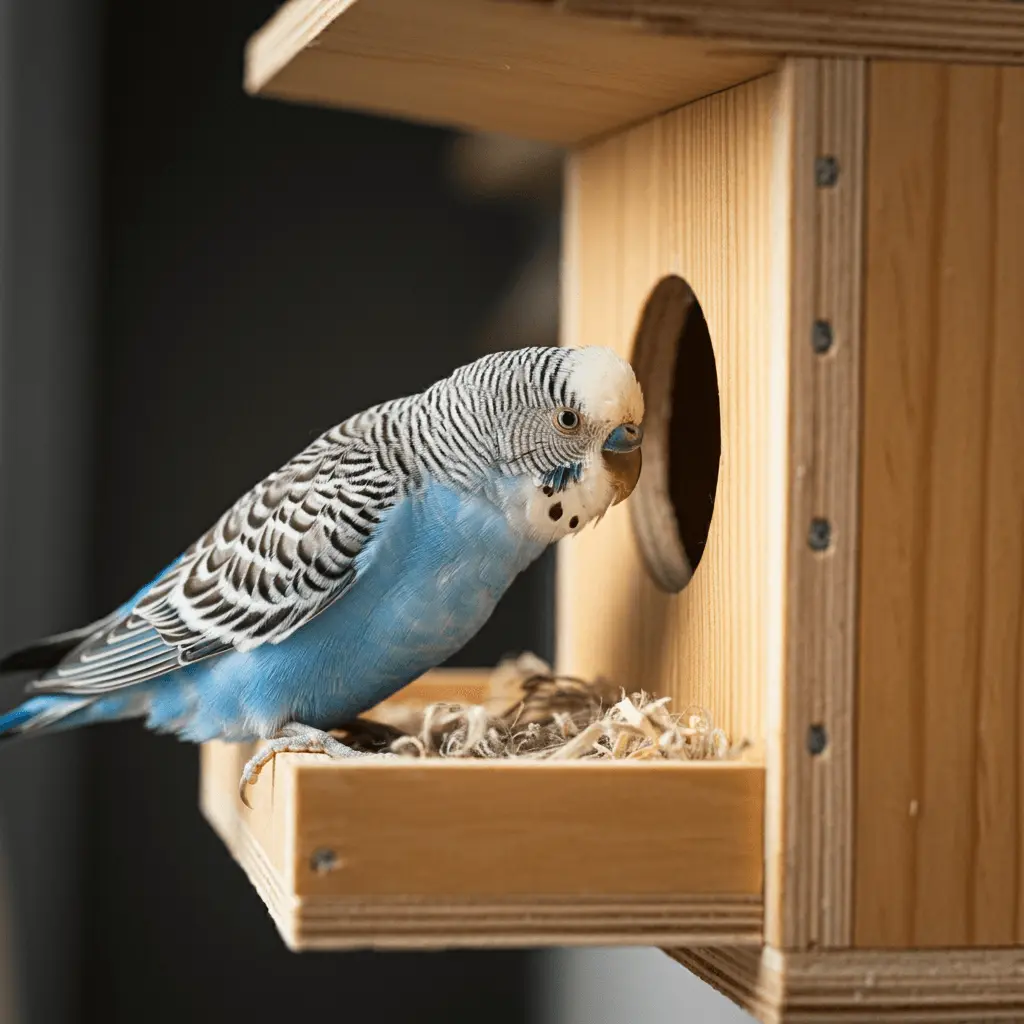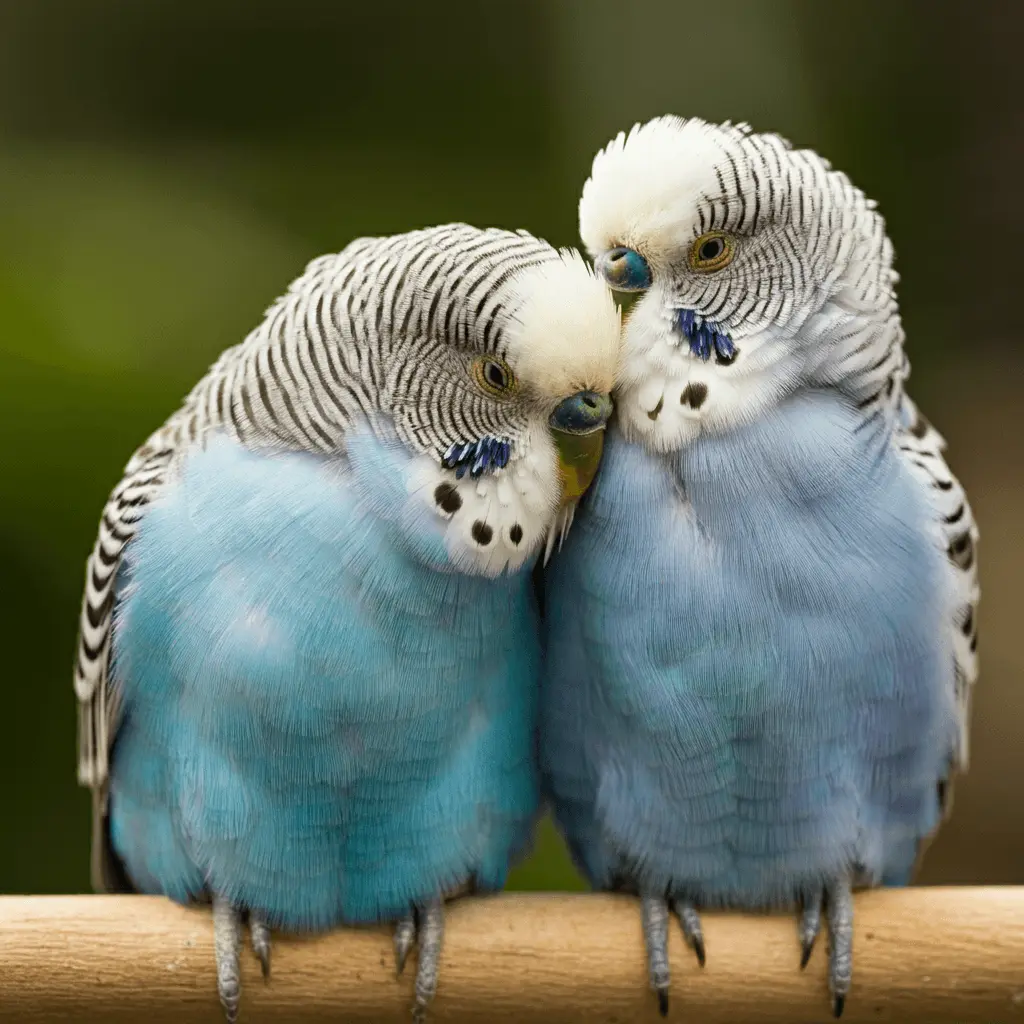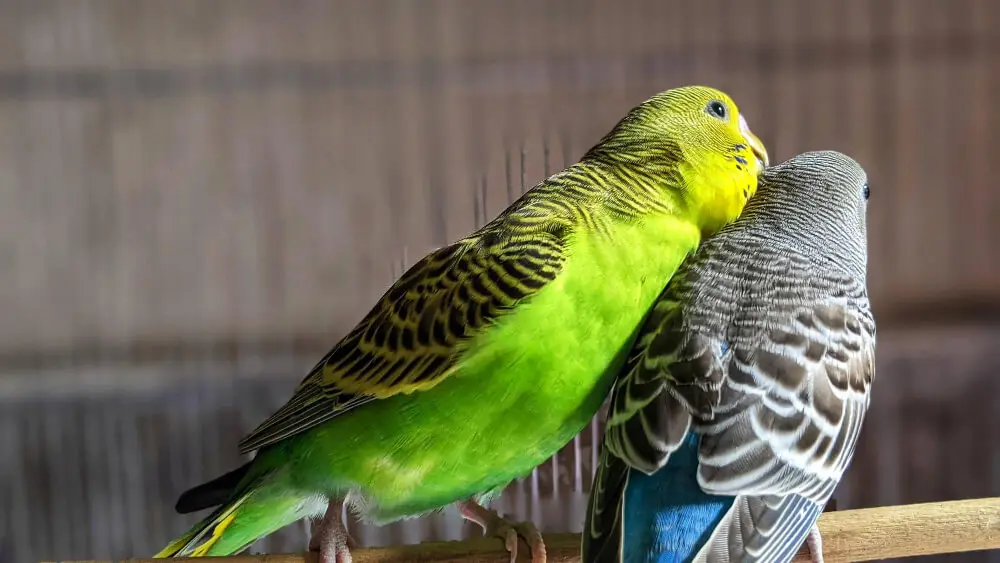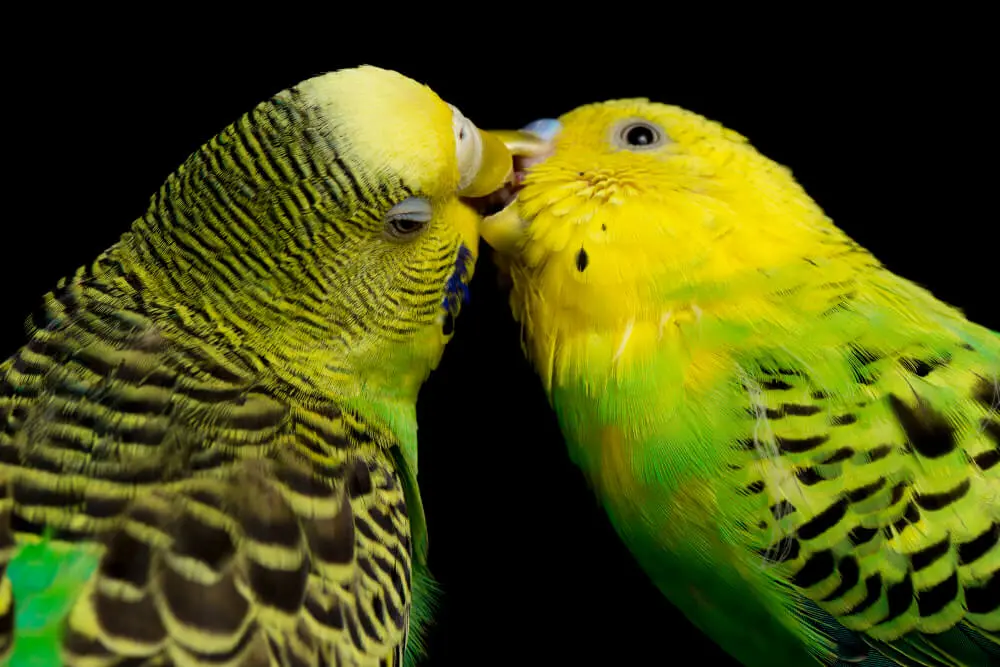Introduction to Budgerigar Mating Rituals and Behavior
Budgerigars, commonly known as budgies, are fascinating creatures with complex social and mating behaviors. Understanding their mating rituals can help bird owners support their budgies during this crucial time and ensure a successful breeding season. In this guide, we’ll explore everything you need to know about budgerigar mating rituals and behavior, from courtship displays to nesting habits.
Budgerigars typically form strong pair bonds with their chosen mates. During the breeding season, you might notice subtle changes in their interactions, including more vocalizations, physical cues like preening, and increased energy. Male budgies usually initiate the courtship by puffing up their feathers, bobbing their heads, and singing to impress the female. These courtship behaviors are key indicators that your budgies are ready to mate.

A pair of green budgerigars engage in courtship feeding, an essential part of their mating ritual. This behavior strengthens the bond between the male and female before mating.
It’s essential to understand these mating rituals so you can create a supportive environment for your birds. Things like providing the right nesting box, ensuring they have a proper diet, and reducing stress are critical to encouraging healthy breeding habits.
By learning how to identify budgie courtship behavior and knowing what to expect from their mating rituals, you’ll not only deepen your bond with your birds but also help them thrive during the breeding process.
Whether you’re a new budgie owner or an experienced bird enthusiast, this guide will help you understand the fascinating world of budgerigar mating behavior and how you can ensure your birds are happy and healthy as they prepare to breed.
Understanding Budgerigar Courtship: Signs to Look For
Budgerigar courtship is an interesting and lively process filled with noticeable signs that indicate when your birds are ready to mate. If you’re paying close attention, you can easily spot the subtle behaviors that budgies display during this time. Understanding these courtship behaviors not only gives you insight into their natural instincts but also helps you provide the right environment for breeding success.
One of the first signs of budgerigar courtship is an increase in vocalizations. Male budgies will often sing more frequently and with greater enthusiasm, trying to impress the female. This singing is usually accompanied by head-bobbing and tail-fanning. These are clear indications that the male is attempting to attract a mate.
Another common behavior is mutual preening. Budgies that are interested in mating will preen each other, particularly around the head and neck areas. This grooming is a way for budgies to strengthen their bond and signal their readiness for mating.
You might also notice the male feeding the female. This behavior, known as “courtship feeding,” is a key part of their bonding process. The male will regurgitate food and feed it to the female as a way of showing he can provide for her during the breeding season.
Lastly, both budgies may become more territorial around their nesting area, especially if a nesting box is available. They might spend more time investigating the box and preparing it for potential eggs.

A blue budgerigar carefully investigates a nesting box as it prepares to mate. Selecting a safe and suitable nesting area is a key behavior in budgerigar mating rituals.
By recognizing these signs of budgie courtship behavior, you can better support your birds during this important time. Creating a comfortable, stress-free environment will encourage healthy mating behavior and improve the chances of a successful breeding season.
The Importance of Mating Rituals in Budgerigar Reproduction
Mating rituals play a vital role in the successful reproduction of budgerigars. These rituals aren’t just about attraction; they serve to strengthen the bond between pairs and ensure both birds are ready for the responsibilities of breeding. Understanding the importance of these behaviors can help you create the right conditions for your budgies to thrive during the breeding season.
In the wild, budgerigar mating rituals help establish trust between the male and female. Courtship displays such as singing, preening, and feeding are essential steps in building a strong connection. Without these behaviors, mating may not occur, as the female will not feel secure enough to reproduce. This is why observing these rituals is a key indicator that your budgies are entering the breeding phase.
The physical gestures involved in courtship—like head-bobbing, mutual preening, and courtship feeding—serve an important purpose. These actions allow budgies to communicate and signal their readiness to mate. For example, when a male budgie feeds the female, it’s a sign that he can provide for her and their potential offspring. This bonding is crucial for creating a stable foundation for reproduction.
Beyond bonding, mating rituals also help regulate the birds’ hormones and prepare them for nesting. When these rituals are allowed to unfold naturally, they stimulate the birds to lay eggs and care for their young. Ignoring these behaviors or failing to create a supportive environment can hinder the reproductive process and even cause stress for your birds.
Providing the right conditions—like a safe nesting area and plenty of space—helps encourage these natural rituals and supports a successful breeding season. By understanding the significance of mating rituals in budgerigar reproduction, you can ensure a healthier, happier experience for both your birds and their future chicks.
Physical Cues: How Budgerigars Prepare for Mating
When budgerigars are preparing to mate, they display several physical cues that signal their readiness. Recognizing these signs can help you understand your birds’ behavior and know when the mating season is approaching. These physical changes are subtle yet important indicators that both male and female budgies are preparing for reproduction.
One of the most noticeable physical cues is the change in the cere (the area above the beak). In male budgies, the cere turns a deep blue during mating season, while in females, it becomes brown and crusty. These color changes are hormonal signals that tell you your budgies are ready to breed.
Another physical cue is feather condition. Male budgies will often fluff up their feathers and bob their heads more energetically to attract the attention of the female. They also engage in tail fanning, a behavior that makes them appear larger and more impressive to potential mates.

A pair of budgerigars engage in head bobbing, a key courtship behavior. This rhythmic movement signals attraction and readiness to mate.
Female budgies, on the other hand, may become more territorial and spend time inspecting nesting areas. You may also notice them shredding paper or chewing on soft materials, which is their way of preparing a nest. This nesting behavior is a strong indicator that your female is getting ready to lay eggs.
In addition to feather and cere changes, both male and female budgies will engage in mutual preening. Preening helps strengthen the bond between the pair, ensuring that they are comfortable with each other before mating. The male may also start feeding the female, a behavior called courtship feeding, which shows that he’s ready to provide for her and any offspring.
By paying attention to these physical cues, you can better understand how budgerigars prepare for mating and take steps to support them during this process. Providing a suitable nesting box and maintaining a stress-free environment will encourage healthy mating behavior, setting your birds up for a successful breeding season.
The Role of Vocalizations During Mating Rituals
Vocalizations play a significant role in budgerigar mating rituals, acting as a key form of communication between potential mates. Understanding these sounds can help bird owners recognize when their budgies are preparing to breed. These vocal cues are not only used for attraction but also for bonding and establishing trust between the birds.
Male budgerigars typically use vocalizations to attract a female’s attention during the courtship phase. These sounds are often more melodic, frequent, and intense compared to their regular chirps. Singing is one of the primary ways males show off their health and vitality, signaling to the female that they are strong and ready to mate. If you notice your male budgie chirping and singing more than usual, it’s likely part of his courtship behavior.
In response, females may also vocalize, though their sounds tend to be softer and more subtle. This interaction helps establish a connection between the pair, laying the groundwork for bonding and future breeding. The back-and-forth exchange of chirps and calls between the male and female is an essential step in the mating process, as it helps solidify their pair bond.
Additionally, vocalizations are used to communicate comfort and reassurance. During mating rituals, you might observe the birds making soft, repetitive sounds as they preen each other or share food. These sounds are a sign that both budgies feel secure with one another, further enhancing their bond and readiness to mate.
By paying close attention to your budgerigars’ vocalizations, you can better understand where they are in their mating rituals. Recognizing these sounds helps you provide the right environment and support for your birds as they move through the stages of courtship, making for a smoother and more successful breeding season.
Common Mating Behaviors in Budgerigars
When budgerigars are ready to mate, they engage in several distinct behaviors that signal their intentions. Recognizing these common mating behaviors can help you understand when your birds are preparing to breed and ensure you provide the right environment to support them during this time. These behaviors are part of the natural budgerigar mating rituals and behavior that foster bonding and lead to successful reproduction.
One of the most notable mating behaviors is head bobbing. Male budgies often bob their heads energetically in front of the female to grab her attention. This display, combined with puffed-up feathers, is meant to showcase the male’s health and vitality, signaling that he’s a strong mate.
Another key behavior is preening, where the male and female groom each other. This isn’t just for cleanliness; it helps deepen the bond between the pair, making them more comfortable with each other before they mate. Preening is an important sign that the budgies are building trust, which is essential for successful breeding.

A pair of budgerigars displays affectionate bonding behavior by sitting closely together. Such actions are critical in strengthening their relationship before mating.
You may also notice the male engaging in courtship feeding, where he regurgitates food and offers it to the female. This is a strong indication that the male is trying to prove he can provide for her and their future offspring. It’s a nurturing behavior that further strengthens their bond and prepares them for the responsibilities of parenthood.
Another common behavior is nesting exploration. Female budgies often become more interested in potential nesting areas, such as nesting boxes, and may start shredding paper or chewing on materials to create a suitable nest. This behavior indicates that the female is preparing to lay eggs, and it’s a clear sign that the pair is close to mating.
Finally, vocalizations play a key role during the mating period. The male budgie may sing more frequently and with more intensity, while the female responds with softer, approving chirps. These exchanges help solidify their connection and signal that mating is imminent.
By observing these common mating behaviors in your budgerigars, you can better support their natural mating process. Providing a calm, nurturing environment will ensure that your birds feel safe and prepared for breeding, setting the stage for a healthy and successful mating season.
How to Support Budgerigars During Mating Season
Supporting your budgerigars during mating season is crucial to ensuring a smooth and successful breeding process. By providing the right environment and care, you can help your birds feel safe, reduce stress, and encourage healthy mating behavior. Here’s what you need to know to give your budgies the best possible support during this time.
First and foremost, setting up a proper nesting area is key. If you haven’t already, provide a comfortable and safe nesting box in their cage. The nesting box should be placed in a quiet, low-traffic area where your birds can feel secure. Make sure the box is clean and has enough space for the female to lay eggs and care for the chicks once they hatch. Adding some soft nesting material, like shredded paper, will give the female a comfortable place to prepare for laying eggs.
Diet is another essential factor in supporting budgerigars during mating season. A well-balanced, nutrient-rich diet helps maintain their energy levels and ensures that both the male and female are healthy enough for breeding. Be sure to offer plenty of fresh vegetables, high-quality seeds, and calcium supplements, especially for the female, as she needs extra calcium for egg production.
Reducing stress is critical during mating season. Budgerigars are sensitive to changes in their environment, so try to keep their surroundings as stable and peaceful as possible. Avoid moving their cage frequently or exposing them to loud noises, as this can disrupt their mating process. Providing a calm, stress-free environment will encourage natural mating behavior and make your budgies feel safe.
You’ll also want to monitor their behavior closely. Watch for signs of budgerigar mating rituals, such as courtship feeding, head-bobbing, and nesting activities. If these behaviors are present, give them space and avoid handling them too much. Over-handling can interrupt the mating process and cause anxiety for your birds.
Lastly, be prepared for potential challenges. Some budgies may experience difficulty during the mating season, such as aggression between pairs or issues with egg-laying. If you notice any unusual behaviors, consult a vet to ensure your birds are in good health and to address any concerns early on.
By providing the right environment, proper nutrition, and a stress-free space, you can effectively support your budgerigars during mating season, leading to a successful breeding experience and healthy chicks.
Challenges and Issues in Budgerigar Mating Behavior
While budgerigar mating behavior is generally smooth, some challenges can arise during the process. Understanding these potential issues can help bird owners provide the necessary support and intervention to ensure a healthy breeding experience for their birds. Identifying and addressing problems early can prevent complications and make the mating season less stressful for both the birds and their owners.
One common issue is aggression between mates. Sometimes, a male or female budgie may become territorial or aggressive, especially if they feel threatened or stressed. This can disrupt the bonding process and hinder successful mating. If you notice aggression, it’s important to provide space for the birds to calm down. In some cases, separating them for a short period and gradually reintroducing them can help ease the tension.
Another challenge is failure to bond. Not all budgies will naturally bond with each other, and if a pair isn’t showing signs of courtship—such as preening, feeding, or nesting behavior—it might indicate that they aren’t compatible. In this case, you may need to introduce a new mate to either the male or female to encourage the formation of a better bond.
Egg binding is a serious issue that can affect female budgies during mating season. This occurs when the female is unable to lay an egg, which can be life-threatening if not addressed quickly. Signs of egg binding include lethargy, a swollen abdomen, and difficulty perching. If you suspect egg binding, it’s essential to seek veterinary assistance immediately to ensure the safety of your bird.
Some budgerigars may also face difficulties during the nesting process. If a female shows signs of preparing to lay eggs but isn’t comfortable with the nesting environment, she may delay the process. Ensuring that the nesting box is clean, safe, and located in a quiet area can help resolve this issue. Providing suitable nesting materials like shredded paper or soft bedding will encourage the female to start nesting.
Finally, hormonal imbalances can sometimes affect a budgerigar’s mating behavior. If your budgie is showing signs of mating readiness but isn’t progressing through the typical rituals, this could be due to a hormonal imbalance. A diet rich in nutrients and a stress-free environment can often help, but if the problem persists, consulting with a vet is recommended.
By being aware of these challenges and issues in budgerigar mating behavior, you can take proactive steps to ensure your birds have the best chance at a successful breeding season. Proper care, attention to their environment, and addressing any health concerns promptly will support healthy reproduction and happier budgies.
Frequently Asked Questions About Budgerigar Mating Rituals
When it comes to budgerigar mating rituals, many bird owners have questions about what to expect and how to best support their birds during this process. Here are some frequently asked questions to help you better understand budgerigar mating behavior and ensure a healthy breeding environment for your birds.
1. How can I tell if my budgerigars are ready to mate?
Budgerigars show several signs when they are ready to mate. Male budgies often engage in head bobbing, puffing up their feathers, and singing to attract a female. You may also see preening between the pair and courtship feeding, where the male offers food to the female. Additionally, the female will start exploring potential nesting areas and may begin preparing a nest by shredding materials.
2. Do budgies need a nesting box for mating?
Yes, a nesting box is essential if you want your budgies to breed. It provides a safe, private space for the female to lay her eggs and care for the chicks. Make sure the box is spacious, clean, and filled with soft materials like shredded paper to create a comfortable environment.
3. What if my budgies are not mating despite showing signs of readiness?
If your budgies are displaying mating behaviors but not progressing to actual breeding, it could be due to environmental factors or stress. Ensure their cage is in a quiet, low-traffic area, and make sure they have proper nutrition, especially calcium for the female. If the issue persists, they may not be compatible as mates, and introducing a new bird might help.
4. How long do budgerigar mating rituals last?
The mating rituals in budgerigars can last several days or even weeks. During this time, the pair will bond through preening, feeding, and vocalizing before actual mating takes place. Once the female is comfortable, she will lay her eggs in the nesting box.
5. Can I handle my budgies during the mating season?
It’s best to limit handling your budgies during mating season. Overhandling can cause stress and disrupt the bonding process between the pair. Giving them space and a peaceful environment will encourage healthy mating behavior.
6. How many eggs do budgerigars lay after mating?
A female budgie typically lays between 4 to 6 eggs, one every other day. After laying all the eggs, she will begin incubating them, and you can expect the chicks to hatch around 18 to 21 days later.
7. What should I feed my budgerigars during the mating season?
Proper nutrition is crucial during the mating season. Provide a well-balanced diet that includes fresh vegetables, high-quality seeds, and calcium-rich foods like cuttlebone or mineral blocks. This ensures both birds are healthy and the female has enough calcium for egg production.
By addressing these common questions, you can better support your budgerigars during their mating rituals, ensuring a smoother, healthier breeding experience for both the birds and their future chicks.
Conclusion: The Importance of Understanding Budgerigar Mating Behavior
Understanding budgerigar mating rituals and behavior is essential for any bird owner who wants to ensure a healthy and successful breeding season. By recognizing the key signs of courtship, knowing how to provide the right environment, and addressing potential challenges, you can support your budgies through this natural process. Mating rituals play a vital role in building trust between pairs, and understanding these behaviors allows you to create an atmosphere that encourages bonding and healthy reproduction.
From recognizing the physical and vocal cues to setting up the perfect nesting area, being aware of your budgies’ needs during mating season helps reduce stress and ensures they thrive. Knowing what to expect in terms of common mating behaviors also allows you to intervene early if any issues arise, such as aggression or difficulty with nesting. By staying attentive and providing proper care, you’re giving your birds the best chance for a successful breeding experience.
In the end, understanding budgerigar mating behavior isn’t just about breeding—it’s about fostering a deeper connection with your birds, supporting their natural instincts, and ensuring their overall well-being. With the right knowledge, you can help your budgerigars enjoy a smooth, healthy, and rewarding mating season.

